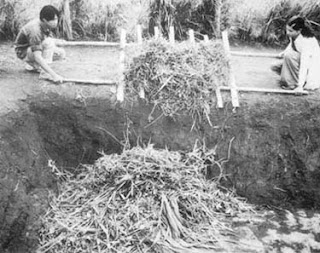
AN OVERVIEW OF TECHNIQUES
FOR MUSHROOM CULTIVATION
Techniques for cultivating mushrooms, whatever the species, follow the same basic pattern.
Whereas two species may differ in temperature requirements, pH preferences or the substrate
on which they grow, the steps leading to fruiting are essentially the same. They can be summarized as follows:
1. Preparation and pouring of agar media into petri dishes.
2. Germination of spores and isolation of pure mushroom mycelium.
3. Expansion of mycelial mass on agar media.
4. Preparation of grain media.
5. Inoculation of grain media with pure mycelium grown on agar media.
6. Incubation of inoculated grain media (spawn).
7. A. Laying out grain spawn onto trays,
or
B. Inoculation of grain spawn into bulk substrates.
8. Casing—covering of substrate with a moist mixture of peat and other materials.
9. Initiation—lowering temperature, increasing humidity to 95%, increasing air circulation,
decreasing carbon dioxide and/or introducing light.
10. Cropping—maintaining temperature, lowering humidity to 85-92%, maintaining air circulation,carbon dioxide and/or light levels.
With many species moderate crops can be produced on cased
grain cultures. Or, the cultivator can go one step further and inoculate compost, straw or wood. In either case, the fruiting of mushrooms requires a high humidity environment that can be readily controlled. Without proper moisture, mushrooms don't grow.In the subsequent chapters standard methods for germinating spores are discussed, followed by Techniques for growing mycelium on agar, producing grain and/or bran "spawn", preparing composted and non-composted substrates, spawn running, casing and pinhead formation. With this last step the methods for fruiting various species diverge and techniques specific to each mushroom are individually outlined. A trouble-shooting guide helps cultivators identify and solve problems that are commonly encountered. This is followed by a thorough analysis of the contaminants and pests of mushroom culture and a chapter explaining the nature of mushroom genetics. In all, the book is a system of knowledge that integrates the various techniques developed by commercial growers worldwide and makes the cultivation of mushrooms at home a practical endeavor.







